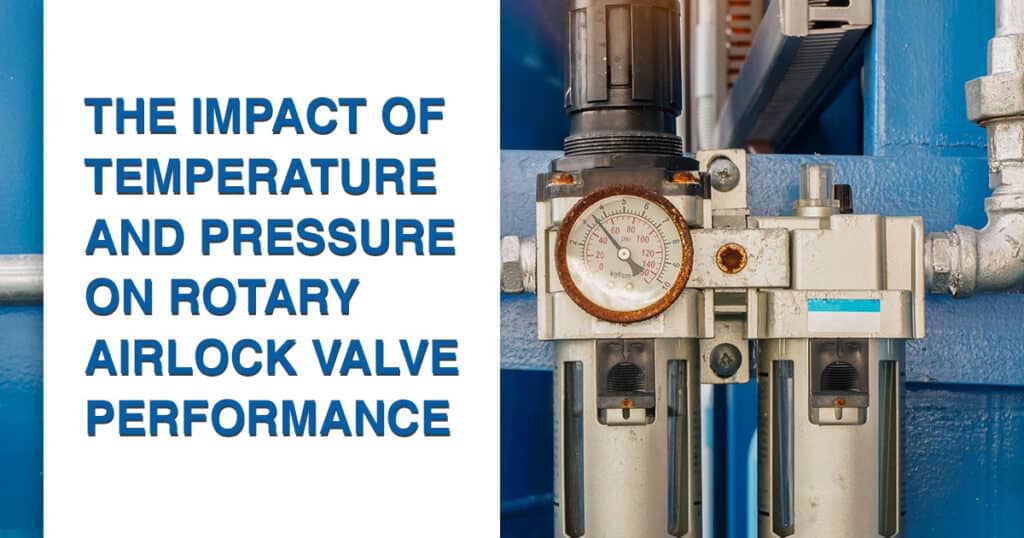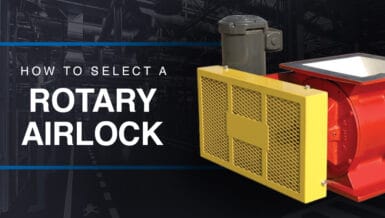To keep air leakage to an absolute minimum, the valve must have extremely tight tolerances between the rotor vanes and the valve housing and covers. These tolerances are usually designed to be compatible with the temperature and pressure differentials of the system into which they’ll be installed. Therefore, it’s important to understand the impact of temperature and pressure on rotary airlock valve performance to achieve peak efficiency.
How does temperature affect rotary airlock valve performance?
Thermodynamics tells us that when a material is heated the increase in energy causes its atoms and molecules to vibrate more rapidly. This makes the material expand, slightly increasing its length, area, and volume. Similarly, when a material is cooled, the decrease in energy leads to less particle movement, causing it to contract.
Now let’s apply that to rotary airlock valve performance.
If you use an airlock in an application with higher-than-expected temperatures, the valve components can expand too much. This is particularly true for the rotor blades, which are heated by hot materials much faster than the housing. Expansion reduces the valve clearances, which can cause the rotor blades to touch the housing or headplates and seize up.
Unless you can reduce the material temperature, the only solution is to increase the valve clearances. But this is an inefficient, labor-intensive task that involves removing the rotor, machining it, reassembling the valve, and testing the clearances before resuming operations. And while this is happening, the downtime and maintenance expenses are putting a serious hole in your plant’s profits.
On the other hand, if the temperature is lower than expected, the rotor will shrink. This could make the valve clearances too large, allowing air to leak between the storage container and pneumatic conveying pipelines.
Minimal end clearances and diameter clearances are essential for preventing air leakage and maintaining an ideal pressure differential. This makes the delicate task of adjusting an existing rotary airlock valve much more difficult than manufacturing a new valve with the correct dimensions. That’s why manufacturers design rotary airlock valves intended for high- or low-temperature application with enough room for the motor to grow or shrink as necessary.
Extreme high or low temperatures can also limit the valve’s construction material, rotor design, and airlock capabilities. When discussing airlocks with your manufacturer, it’s important that you provide correct maximum temperatures for both your product and the processing environment. That way, they can construct the most efficient rotary airlock valve for your needs.
How does pressure affect rotary airlock valve performance?
The storage container and pipelines in your pneumatic conveying system are differently pressured environments. To ensure smooth, consistent flow of materials, you need to maintain a pressure differential between them.
Some air leakage is to be expected, as the airlock rotor must have small clearances in order to turn. A small portion of air from the outlet stays within the rotor and is pushed back into the inlet as it turns. This is called rotor displacement leakage or blow-by, and in small amounts is perfectly normal.
Excessive air leakage, however, poses a serious problem for both positive pressure and negative pressure (vacuum) pneumatic conveying systems. High upward leakage can interfere with material flow by both reducing bulk density through fluidization and creating a physical barrier. It can also make hard fine particles more abrasive, increase moisture transfer, and create unstable flow conditions that require downtime to fix.
When designing a rotary airlock valve, the manufacturer needs to consider the bulk density of the material and how it’s affected by the pressure differential. Materials that are easily fluidized, like powders, can require a larger valve to compensate for their poor pocket-fill efficiency while feeding into a pressure system. Similarly, high-pressure environments will need a more durable feeder and perhaps even additional venting system to stop air leakage from interfering with product flow.
Achieve ideal tolerances with custom airlocks from Progressive Products Inc.
The temperatures and pressures within your pneumatic conveying system have a significant impact on the performance of your rotary airlock valve. So when you’re looking for a manufacturer to design the perfect component, you need to have confidence in their experience and abilities.
The expert team at Progressive Products Inc. has been designing industry-leading pneumatic conveying components for more than 40 years. We provide manufacturers worldwide with reliable airlocks with tight tolerances and maintenance-free seals, all with no field adjustments required. Our configurations protect against a range of operating conditions and material characteristics, with T-seals available for top performance in severe operating conditions.











































